Merits, Demerits, Example Solved Problems - Methods of Measuring Secular Trend | 12th Statistics : Chapter 7 : Time Series and Forecasting
Chapter: 12th Statistics : Chapter 7 : Time Series and Forecasting
Methods of Measuring Secular Trend
Secular trend
It refers to the long term tendency of the data to move in an
upward or downward direction. For example, changes in productivity, increase in
the rate of capital formation, growth of population, etc ., follow
secular trend which has upward direction, while deaths due to improved medical
facilities and sanitations show downward trend. All these forces occur in slow
process and influence the time series variable in a gradual manner.
Methods of Measuring Trend
Trend is measured using by the following methods:
1. Graphical method
2. Semi averages method
3. Moving averages method
4. Method of least squares
1. Graphical Method
Under this method the values of a time series are plotted on a
graph paper by taking time variable on the X-axis and the values
variable on the Y-axis. After this, a smooth curve is drawn with free
hand through the plotted points. The trend line drawn above can be extended to
forecast the values. The following points must be kept in mind in drawing the
freehand smooth curve.
(i) The curve should be smooth
(ii) The number of points above the line or
curve should be approximately equal to the points below it
(iii) The sum of the squares of the vertical deviation of the
points above the smoothed line is equal to the sum of the squares of the
vertical deviation of the points below the line.
Merits
·
It is simple method of estimating trend.
·
It requires no mathematical calculations.
·
This method can be used even if trend is not linear.
Demerits
·
It is a subjective method
·
The values of trend obtained by different statisticians would be different
and hence not reliable.
Example 7.1
Annual power consumption per household in a certain locality was
reported below.

Draw a free hand curve for the above data.
Solution:
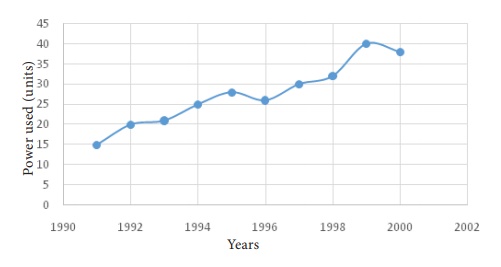
2. Semi-Average Method
In this method, the series is divided into two equal parts and the
average of each part is plotted at the mid-point of their time duration.
(i) In case the series consists of an even
number of years, the series is divisible into two halves. Find the average of
the two parts of the series and place these values in the mid-year of each of
the respective durations.
(ii) In case the series consists of odd number of years, it is not
possible to divide the series into two equal halves. The middle year will be
omitted. After dividing the data into two parts, find the arithmetic mean of
each part. Thus we get semi-averages.
(iii) The trend values for other years can be computed by
successive addition or subtraction for each year ahead or behind any year.
Merits
·
This method is very simple and easy to understand
·
It does not require many calculations.
Demerits
·
This method is used only when the trend is linear.
·
It is used for calculation of averages and they are affected by
extreme values.
Example 7.2
Calculate the trend values using semi-averages methods for the
income from the forest department. Find the yearly increase.

Source: The Principal Chief conservator of forests, Chennai-15.
Solution:
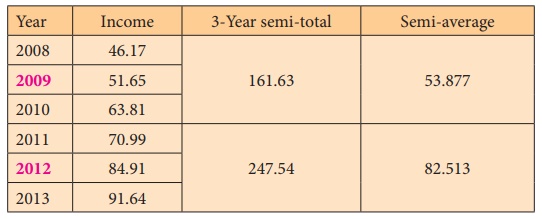
Difference between the central years = 2012 – 2009 = 3
Difference between the semi-averages = 82.513 – 53.877 = 28.636
Increase in trend value for one year = 28.636 /3 = 9.545
Trend values for the previous and successive years of the central
years can be calculated by subtracting and adding respectively, the increase in
annual trend value.
Example 7.3
Population of India for 7 successive census years are given below. Find the trend values using semi-averages method.

Solution:
Trend values using semi average method

Difference between the years = 2001 – 1961 = 40
Difference between the semi-averages = 634.7 – 350.03 = 284.67
Increase in trend value for 10 year = 284.67 / 4 = 71.17
For example the trend value for the year 1951 = 350.03 – 71.17 =
278.86 The value for the year 2011 = 634.7 + 71.17 = 705.87
The trend values have been calculated by successively subtracting
and adding the increase in trend for previous and following years respectively.
Example 7.4
Find the trend values by semi-average method for the following
data.

Solution:
Trend values using semi averages method
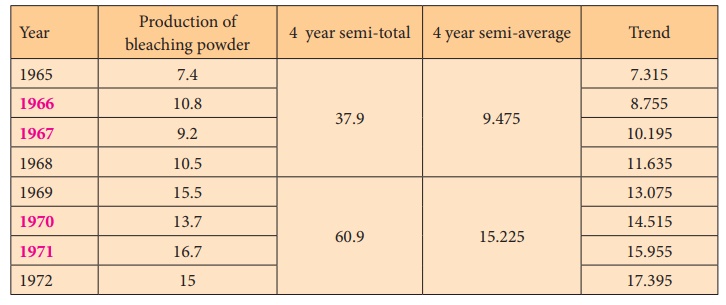
Difference between the years = 1970.5 – 1966.5 = 4
Difference between the semi-averages = 15.225 – 9.475 = 5.75
Increase in trend = 5 .75 / 4 = 1.44
Half yearly increase in trend = 1.44 / 2 = 0.72
The trend value for 1967 = 9.475 + 0.72 = 10.195
The trend value for 1968 = 9.475 + 3 * 0.72 = 11.635
Similarly the trend values for the other years can be calculated.
3. Moving Averages Method
Moving averages is a series of arithmetic means of variate values
of a sequence. This is another way of drawing a smooth curve for a time series
data.
Moving averages is more frequently used for eliminating the
seasonal variations. Even when applied for estimating trend values, the moving
average method helps to establish a trend line by eliminating the cyclical,
seasonal and random variations present in the time series. The period of the
moving average depends upon the length of the time series data.
The choice of the length of a moving average is an important
decision in using this method.
For a moving average, appropriate length plays a significant role
in smoothening the variations.
In general, if the number of years for the moving average is more
then the curve becomes smooth.
Merits
·
It can be easily applied
·
It is useful in case of series with periodic fluctuations.
·
It does not show different results when used by different persons
·
It can be used to find the figures on either extremes; that is,
for the past and future years.
Demerits
·
In non-periodic data this method is less effective.
·
Selection of proper ‘period’ or ‘time interval’ for computing
moving average is difficult.
·
Values for the first few years and as well as for the last few
years cannot be found.
Moving averages odd number of years (3 years)
To find the trend values by the method of three yearly moving
averages, the following steps have to be considered.
·
Add up the values of the first 3 years and place the yearly sum
against the median year. [This sum is called moving total]
·
Leave the first year value, add up the values of the next three
years and place it against its median year.
·
This process must be continued till all the values of the data are
taken for calculation.
·
Each 3-yearly moving total must be divided by 3 to get the 3-year
moving averages, which is our required trend values.
Example 7.5
Calculate the 3-year moving averages for the loans issued by
co-operative banks for non-farm sector/small scale industries based on the
values given below.

Solution:
The three year moving averages are shown in the last column.

Moving averages - even number of years (4 years)
·
Add up the values of the first 4 years and place the sum against
the middle of 2nd and 3rd year. (This sum is called 4
year moving total)
·
Leave the first year value and add next 4 values from the 2nd year
onward and write the sum against its middle position.
·
This process must be continued till the value of the last item is
taken into account.
·
Add the first two 4-years moving total and write the sum against
3rd year.
·
Leave the first 4-year moving total and add the next two 4-year
moving total and place it against 4th year.
·
This process must be continued till all the 4-yearly moving totals
are summed up and centered.
·
Divide the 4-years moving total by 8 to get the moving averages
which are our required trend values.
Example 7.6
Compute the trends by the method of moving averages, assuming that
4-year cycle is present in the following series.

Solution:
The four year moving averages are shown in the last column.
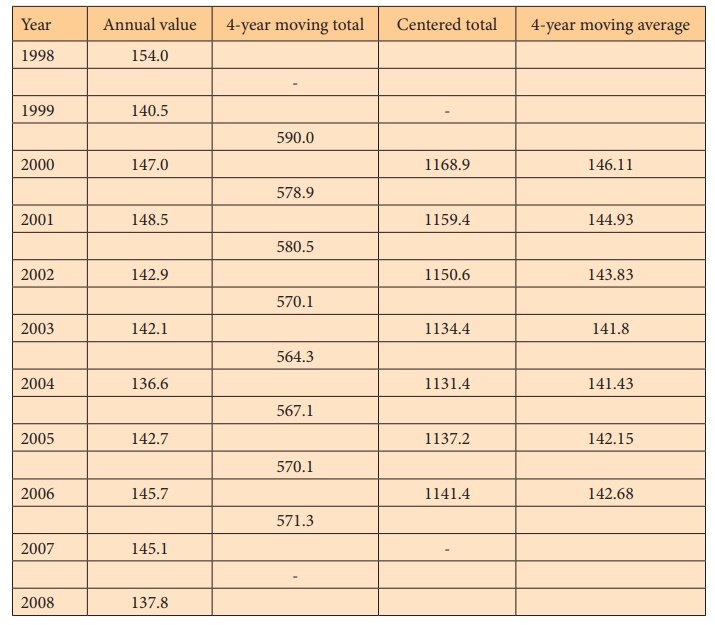
4. Method of least squares
Among the four components of the time series, secular trend
represents the long term direction of the series. One way of finding the trend
values with the help of mathematical technique is the method of least squares.
This method is most widely used in practice and in this method the sum of
squares of deviations of the actual and computed values is least and hence the
line obtained by this method is known as the line of best fit.
It helps for forecasting the future values. It plays an important
role in finding the trend values of economic and business time series data.
Computation of Trend using Method of Least squares
Method of least squares is a device for finding the equation which
best fits a given set of observations.
Suppose we are given n pairs of observations and it is
required to fit a straight line to these data. The general equation of the
straight line is:
y = a + bx
where a and b are constants. Any value of a
and b would give a straight line, and once these values are obtained an
estimate of y can be obtained by substituting the observed values of y.
In order that the equation y = a + b x gives a good representation
of the linear relationship between x and y, it is desirable that
the estimated values of yi, say y^ i
on the whole close enough to the observed values yi,
i = 1, 2, …, n. According to the principle of least squares, the best
fitting equation is obtained by minimizing the
sum of squares of differences
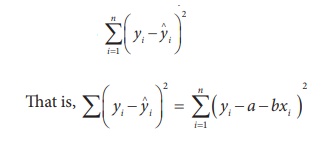
is minimum. This leads us to two normal equations.

Solving these two equations we get the vales for a and b
and the fit of the trend equation (line of best):
y = a + bx (7.3) (7.3)
Substituting the observed values xi in (7.3) we
get the trend values yi, i = 1, 2, …, n.
Note: The time unit is usually of uniform duration and occurs in
consecutive numbers. Thus, when the middle period is taken as the point of origin, it reduces
the sum of the time variable x to
zero  and hence we get
and hence we get

by simplifying (7.1) and (7.2)
The number of time units may be even or odd, depending upon this,
we follow the method of calculating trend values using least square method.
Merits
·
The method of least squares completely eliminates personal bias.
·
Trend values for all the given time periods can be obtained
·
This method enables us to forecast future values.
Demerits
·
The calculations for this method are difficult compared to the
other methods.
·
Addition of new observations requires recalculations.
·
It ignores cyclical, seasonal and irregular fluctuations.
·
The trend can be estimated only for immediate future and not for
distant future.
Steps for calculating trend values when n is odd:
(i) Subtract the first year from all the years (x)
(ii) Take the middle value (A)
(ii) Find ui = xi
– A
(iv) Find ui2 and uiyi
Then use the normal equations:
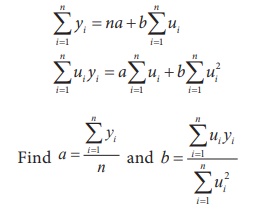
Then the estimated equation of straight line is:
y = a + b u = a + b (x – A)
Example 7.7
Fit a straight line trend by the method of least squares for the
following consumer price index numbers of the industrial workers.

Solution:
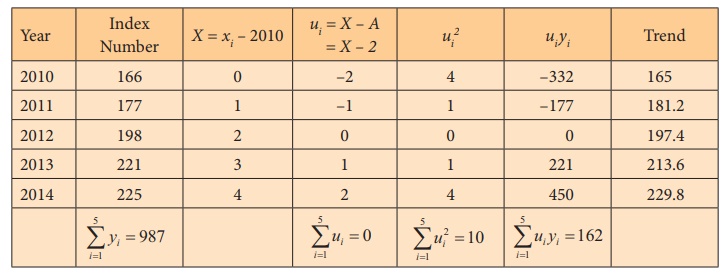
The equation of the straight line is y = a + bx
= a + bu where u = X – 2
The normal equations give:
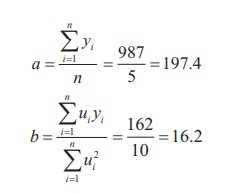
y = 197.4 + 16.2 (X – 2)
= 197.4 + 16.2 X – 32.4
= 16.2 X + 165
That is, y = 165 + 16.2X
To get the required trend values, put X = 0, 1, 2, 3, 4 in
the estimated equation.
X = 0, y = 165 + 0 = 165
X = 1, y = 165 + 16.2 = 181.2
X = 2, y = 165 + 32.4 = 197.4
X = 3, y = 165 + 48.6 = 213.6
X = 4, y = 165 + 64.8 = 229.8
Hence, the trend values for 2010, 2011, 2012, 2013 and 2014 are
165, 181.2, 197.4, 213.6 and 229.8 respectively.
Steps for calculating trend values when n is even:
i). Subtract the first year from all the years (x)
ii). Find ui = 2X – (n – 1)
iii). Find ui2 and ui
yi
Then follow the same procedure used in previous method for odd
years
Example 7.8
Tourist arrivals (Foreigners) in Tamil Nadu for 6 consecutive
years are given in the following table. Calculate the trend values by using the
method of least squares.

Solution:
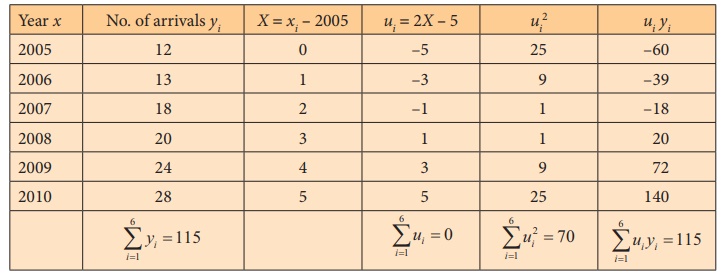
The equation of the straight line is y = a + bx
= a + bu where u = 2X – 5
Using the normal equation we have,
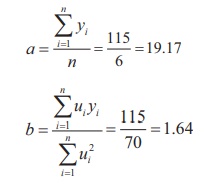
y = a + bu
= 19.17 + 1.64 (2X – 5)
= 19.17 + 3.28X – 8.2
= 3.28X + 10.97
That is, y = 10.97 + 3.28X
To get the required trend values, put X = 0, 1, 2, 3, 4, 5
in the estimated equation. Thus,
X = 0, y = 10.97 + 0 = 10.97
X = 1, y = 10.97 + 3.28 = 14.25
X = 2, y = 10.97 + 6.56 = 17.53
X = 3, y = 10.97 + 9.84 = 20.81
X = 4, y = 10.97 + 13.12 = 24.09
X = 5, y = 10.97 + 16.4 = 27.37
Hence, the trend values for 2005, 2006, 2007, 2008, 2009 and 2010
are 10.97, 14.25, 17.53, 20.81, 24.09 and 27.37 respectively.
Related Topics